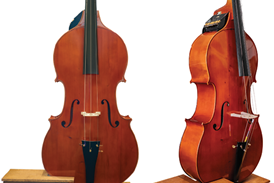Celia Cobb examines an unusual method for practising with different clefs and key signatures

Singende Saiten: Die schönsten Solostücke für Violine oder Bratsche
Ed. Felix Forrer
32PP ISBN 9790004792100
NEPOMUK £17.55
Singing Strings is the first in a series of three books of ‘the most beautiful pieces for violin or viola’. The first half of this volume contains an interesting mix of English folk songs from John Simpson’s c.1756 The Compleat Tutor for the Violin interspersed with tunes from various Handel operas, while the remainder of the book is a collection of suites by assorted Baroque composers. The pieces are sparingly and sensibly edited, and are suitable for students playing at ABRSM Grades 2 to 4.
The book’s unique selling point is that every piece is presented on a stave with only four lines. To play each piece, the performer first needs to draw a line across either the top (for violin) or the bottom (for viola) of the printed staves, then insert a clef and key signature at the beginning of each line. With nearly 50 pieces in the book, that’s quite a lot of line drawing and clef and key signature writing, and while I can imagine a certain amount of eye-rolling from some of my students about this, there’s no denying that it would give them some much-needed practice in this area.
As I worked through the book, diligently constructing my staves and writing in my clefs and key signatures, I ran into a few issues. Although I was reasonably careful to draw my lines neatly, when playing the pieces I found it hard to cope with being able to see the printed leger lines under my hand-drawn lines, and my fingers fumbled momentarily on notes such as F sharp (top line, treble clef). In addition, the usual stem directions of some of the notes were reversed, which made my brain ache a little. To test out the author’s assertion that ‘the special notation… is an ideal form to facilitate the “conversion” from violin to viola’, I duly had a go at a few pieces on both instruments, but with only moderate success. Although the notation allows the pieces to be played on the violin or the viola with the same fingering, the pieces are (as the author acknowledges) played in different keys, which felt rather unhelpful. And, since there is only one version of the tune presented in the book, switching between instruments and clefs involved an awful lot of rubbing out and redrawing of lines, clefs and key signatures. There are definitely simpler and more effective ways for a violinist to try out the alto clef, and vice versa.
I really wanted to fall in love with this book, with its homely looking hand-drawn cover and its editor’s clear passion for his system. It is obvious that a great deal of thought has gone into selecting, organising and arranging the book’s musical contents, and the theory geek in me revelled at the prospect of being able to ask students to write their clefs and key signatures so many times. I liked the pieces and the way they were grouped by key, and I particularly loved the inclusion of the Baroque dance suites, which would each make a lovely set for a young student to work towards performing. But ultimately I found that the ‘unique four-stave format’ just didn’t work for me. Which is not to say that it won’t work for you. So, if you are looking for something a bit different, perhaps a quirky gift for an open-minded upper strings player, or simply something unusual for yourself, then this book might be exactly the hidden gem you have always been searching for and I recommend you give it a go, just to see.
CELIA COBB









































No comments yet